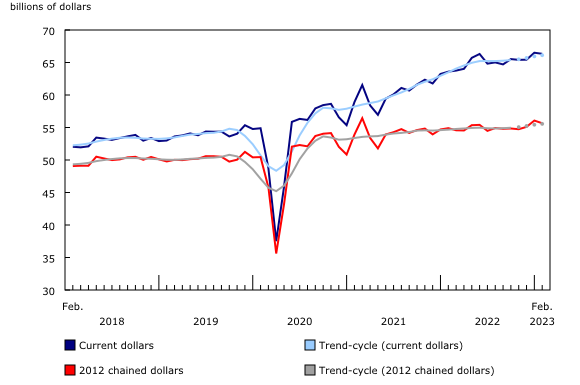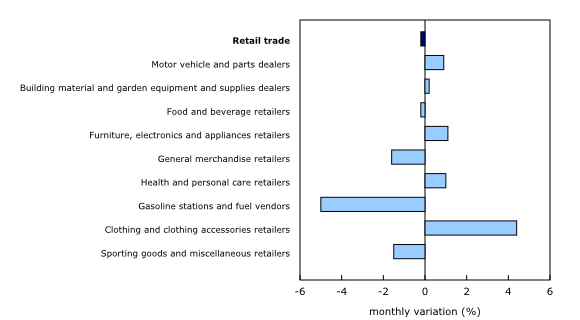Retail trade, February 2023
Archived Content
Information identified as archived is provided for reference, research or recordkeeping purposes. It is not subject to the Government of Canada Web Standards and has not been altered or updated since it was archived. Please "contact us" to request a format other than those available.
Released: 2023-04-21
$66.3 billion
February 2023
-0.2% 
(monthly change)
$1.0 billion
February 2023
-0.4% 
(monthly change)
$0.3 billion
February 2023
1.1% 
(monthly change)
$1.8 billion
February 2023
-2.3% 
(monthly change)
$1.5 billion
February 2023
5.1% 
(monthly change)
$14.8 billion
February 2023
0.9% 
(monthly change)
$25.0 billion
February 2023
0.8% 
(monthly change)
$2.3 billion
February 2023
-3.2% 
(monthly change)
$2.1 billion
February 2023
-3.0% 
(monthly change)
$8.6 billion
February 2023
-0.9% 
(monthly change)
$8.8 billion
February 2023
-3.3% 
(monthly change)
$0.1 billion
February 2023
-1.2% 
(monthly change)
$0.1 billion
February 2023
0.4% 
(monthly change)
$0.1 billion
February 2023
0.7% 
(monthly change)
Retail sales decreased 0.2% to $66.3 billion in February. Sales decreased in 4 of 9 subsectors, representing 48.0% of retail trade. The decrease was led by lower sales at gasoline stations and fuel vendors (-5.0%) and general merchandise retailers (-1.6%).
Core retail sales—which exclude gasoline stations and fuel vendors and motor vehicle and parts dealers—increased 0.1%.
In volume terms, retail sales decreased 0.7% in February.
Sales at gasoline stations and fuel vendors fall, while sales at motor vehicle and parts dealers rise
Leading the decrease in retail sales in February were lower sales at gasoline stations and fuel vendors (-5.0%). In volume terms, sales at gasoline stations and fuel vendors decreased 4.9%. Gasoline prices fell 1.0% on an unadjusted basis in February, amid higher crude oil inventory levels within the United States.
The largest increase to retail sales came from motor vehicle and parts dealers (+0.9%), their seventh consecutive increase. The gain was led by higher sales at new car dealers (+0.7%), followed by used car dealers (+4.2%) and automotive parts, accessories and tire retailers (+2.5%).
Core retail sales edge higher
Core retail sales edged up 0.1% in February, led by higher sales at clothing, clothing accessories, shoes, jewellery, luggage and leather goods retailers (+4.4%). The increase was observed across all three store types, with sales at clothing and clothing accessories retailers (+4.9%) posting their largest increase since the same month a year prior.
The largest decrease to core retail sales came from general merchandise retailers (-1.6%). Sales have declined in this subsector for two out of the last four months.
Sales down in six provinces
Retail sales decreased in six provinces in February. The largest provincial decrease was observed in British Columbia (-3.3%) led by lower sales at motor vehicle and parts dealers. In the census metropolitan area of Vancouver, sales were down 4.4%.
In Alberta, retail sales decreased 0.9% and were led by lower sales at gasoline stations and fuel vendors.
Retail sales were down in Manitoba (-3.2%) and were also driven by lower sales at motor vehicle and parts dealers.
Retail e-commerce sales in Canada
On a seasonally adjusted basis, retail e-commerce sales were up 7.8% to $3.7 billion in February, accounting for 5.5% of total retail trade, compared with 5.1% in January.
Advance retail indicator
Given the continually evolving economic situation, Statistics Canada is providing an advance estimate of retail sales, which suggests that sales decreased 1.4% in March. Owing to its early nature, this figure will be revised. This unofficial estimate was calculated based on responses received from 28.4% of companies surveyed. The average final response rate for the survey over the previous 12 months has been 89.9%.
Note to readers
As of the January 2023 reference period, Monthly Retail Trade Survey (MRTS) figures are now based on the North American Industry Classification System (NAICS) 2022 classification structure. This new classification structure has, in effect, broadened the scope of the MRTS results.
Table 20-10-0008 has been archived. Seasonally adjusted estimates in NAICS 2022 are now available in table 20-10-0056 starting in 2017. Unadjusted estimates starting in 2017 are now available in table 20-10-0056.
Table 20-10-0078 has also been archived. Volume estimates and indices in NAICS 2022 starting in 2017 are now available in table 20-10-0067.
Seasonal adjustment specifications and factors were reviewed and updated based on the NAICS 2022 classification structure. Regular annual revisions from 2022 were also included in the new data series. The data have been revised using historical linkage factors designed to preserve the continuity of the time series. This linkage method leads to larger revisions for more recent periods.
The overarching theme of the update is the digital economy. Online-only retailers are now classified in the same industrial groupings as their non-digital counterparts. This means that some industries have been reclassified to reflect both physical and online-only retailers, creating a change in how some industry groups are measured and a shift in some of the time series. In other cases, industries with the same definition will have different categorization numbers due to the overall changes to the classification.
All data in this release are seasonally adjusted and expressed in current dollars, unless otherwise noted.
Seasonally adjusted data are data that have been modified to eliminate the effect of seasonal and calendar influences to allow for more meaningful comparisons of economic conditions from period to period. For more information on seasonal adjustment, see Seasonally adjusted data – Frequently asked questions.
The percentage change for the advance estimate of retail sales is calculated using seasonally adjusted data and is expressed in current dollars.
This early indicator is a special unofficial estimate being provided in the context of the COVID-19 pandemic to offer Canadians timely information on the retail sector. The data sources and methodology used are the same as those outlined on the Monthly Retail Trade Survey information page.
Trend-cycle estimates are included in selected charts as a complement to the seasonally adjusted series. These data represent a smoothed version of the seasonally adjusted time series and provide information on longer-term movements, including changes in direction underlying the series. For information on trend-cycle data, see Trend-cycle estimates – Frequently asked questions.
Both seasonally adjusted data and trend-cycle estimates are subject to revision as additional observations become available. These revisions could be extensive and could even lead to a reversal of movement, especially for the reference months near the end of the series or during periods of economic disruption.
Seasonally adjusted estimates for cannabis store retailers are presented in unadjusted form, as no seasonal pattern has been established by official statistics yet. Establishing such a pattern requires several months of observed data. In the interim, the seasonally adjusted estimates for cannabis store retailers will be identical to the unadjusted figures.
Some common e-commerce transactions, such as travel and accommodation bookings, ticket purchases and financial transactions, are not included in Canadian retail sales figures.
Total retail sales expressed in volume terms are calculated by deflating current-dollar values using consumer price indexes.
Find more statistics on retail trade.
Next release
Data on retail trade for March will be released on May 19.
Contact information
For more information, or to enquire about the concepts, methods or data quality of this release, contact us (toll-free 1-800-263-1136; 514-283-8300; infostats@statcan.gc.ca) or Media Relations (statcan.mediahotline-ligneinfomedias.statcan@statcan.gc.ca).
- Date modified:



